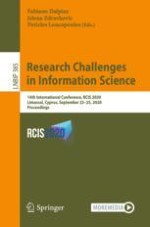This book constitutes the proceedings of the 14th International Conference on Research Challenges in Information Sciences, RCIS 2020, held in Limassol, Cyprus, during September 23-25, 2020. The conference was originally scheduled for May 2020, but the organizing committee was forced to postpone the conference due to the outbreak of the COVID-19 pandemic.
The scope of RCIS 2020 is summarized by the thematic areas of information systems and their engineering; user-oriented approaches; data and information management; business process management; domain-specific information systems engineering; data science; information infrastructures, and reflective research and practice.
The 26 full papers and 3 work in progress papers presented in this volume were carefully reviewed and selected from 106 submissions. They were organized in topical sections named:
Data Analytics and Business Intelligence; Digital Enterprise and Technologies; Human Factors in Information Systems; Information Systems Development and Testing; Machine Learning and Text Processing; and Security and Privacy. The volume also contains 12 poster and demo-papers, and 4 Doctoral Consortium papers.
